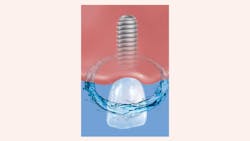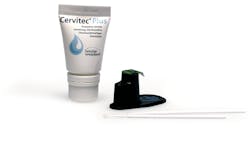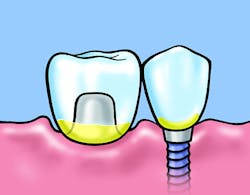Biofilm-focused care protocols for natural teeth, implants, and restorations
It’s an exciting time to be in dentistry, with new products to restore natural dentition and implants to replace missing teeth. Dental and medical professionals have joined together as first responders to focus on biofilm and its role in inflammation and oral-systemic disease.
Protecting our patients’ health, dentition, and restorations by addressing biofilm and non-biofilm induced inflammation starts with a paradigm shift in hygiene protocols, technology, and products. To address this challenge, new guidelines for maintenance and recare for tooth- and implant-borne restorations have been developed, as well as a new classification for disease treatment.
The American College of Prosthodontists (ACP) developed a set of clinical practice guidelines for recall and maintenance of patients with tooth-borne and implant-borne restorations.1 This is a good place to start with modifications to our maintenance protocols and recommendation that all patients of record be advised to present for in-office maintenance at least every six months to protect their restorations, and most importantly, their overall health.1
The ACP guidelines include the use of low-abrasion powder-streaming technology at the beginning of the maintenance visit to remove biofilm prior to probing or assessment. Monitoring occlusion is especially important for implant-borne restoration patients. If grinding or clenching is detected, adjustment to the occlusion is recommended, and a prescribed occlusal device may be needed to protect fixed restorations. At-home care maintenance for the patient should include the use of oral hygiene aids to disrupt the biofilm (e.g., dental floss, water flosser, interdental cleaners, electric toothbrushes).1
The American Academy of Periodontology (AAP) and the European Federation of Periodontology (EFP) developed a new classification of periodontal and peri-implant disease and conditions. The classification follows a medical model that allows clinicians to explain treatment to patients based on stage, extent, and progression. The 2017 World Workshop on the Classification of Periodontal and Peri-Implant Diseases and Conditions provided 19 review papers and four consensus reports that outline classification and conditions affecting the periodontium and biofilm-induced and nonbiofilm-induced inflammation.2-4
By focusing on biofilm, this classification and its guidelines change how dental professionals approach maintenance and home-care recommendations. New protocols, technology, and products are now available to remove biofilm, prevent biofilm formation, and protect teeth and implants.
Detect, diagnose, and treat
Detection and diagnosis begin with a comprehensive dental exam, an up-to-date medical history, and full-mouth probing (FMP) that includes a new focus on bleeding points for inflammation identification. Below are some possible additions to your recare maintenance and disease treatment protocol for patients with natural teeth, restorations, implants, or all three.5
Test patients’ saliva to identify pH and risk factors for disease and other conditions affecting the periodontium. Use products to identify plaque and biofilm and use powder-streaming technology with erythritol and glycine powder to remove the biofilm. Another consideration is to routinely use fluoride or antimicrobial varnishes to protect natural teeth and implants. Recommend neutral pH home-care products for all patients with tooth-borne and implant-borne restorations.
Biofilm-focused care should include the use of fluoride varnishes, and any products used should be of a neutral pH, especially if implants are present. Examples of varnishes that are neutral and safe to use around teeth and implants include Fluor Protector (Ivoclar Vivadent), MI Varnish (GC America), and Vella (Preventech). Fluoride varnishes are recommended for caries prevention and sensitivity on natural dentition.
Cervitec Plus contains chlorhexidine diacetate (not gluconate) and thymol, and does not contain fluoride. It is formulated to be nonstaining and effectively control bacteria, and it is recommended for use in all age groups on natural detention and implants. In an in-vivo study of 30 patients, it reduced the presence of Porphyromonas gingivalis, which has been shown to drive biofilm formation, for up to three months.6 In addition, it has been shown to be 20% more effective in controlling gingival bleeding as an adjunct therapy following periodontal disease treatment of scaling and root planing (SRP) than SRP alone.7
As dental professionals, this is a vital time to protect our patients’ teeth, implants, restorations, and most importantly, overall health. Our goal with new biofilm-focused care protocols and innovative products is to eliminate inflammation that can initiate the inflammatory cascade. The inflammatory cascade starts with tissue breakdown and can lead to bone loss in teeth and around implants.
The ACP’s “Clinical practice guidelines for recall and maintenance of patients with tooth-borne and implant-borne dental restorations” and the AAP/EFP periodontal and peri-implant disease classification information are a good place to begin. Gather the guidelines, classification, protocols, and products to take your practice into biofilm-focused care.
Editor's note: View Susan Wingrove's companion treatment protocol reference to this article here.
Read more: Are you compromising your patient’s implant?
References
- Bidra AS, Daubert DM, Garcia LT, et al. Clinical practice guidelines for recall and maintenance of patients with tooth-borne and implant-borne dental restorations. J Prosthodont. 2016;25 Suppl 1:S32-S40. doi:10.1111/jopr.12416
- Caton G, Armitage G, Berglundh T, et al. A new classification scheme for periodontal and peri‐implant diseases and conditions – Introduction and key changes from the 1999 classification. J Clin Periodontol. 2018;45 Suppl 20:S1-S8. doi:10.1111/jcpe.12935
- Froum S. The new classification of periodontal disease that you, your patient, and your insurance company can understand. Perio-Implant Advisory website. https://www.perioimplantadvisory.com/clinical-tips/article/16412257/the-new-classification-of-periodontal-disease-that-you-your-patient-and-your-insurance-company-can-understand. Published August 30, 2018.
- Wingrove S. Clinical applications for the 2018 classification of peri-implant diseases and conditions. Perio-Implant Advisory website. https://www.perioimplantadvisory.com/clinical-tips/hygiene-techniques/article/16412254/clinical-applications-for-the-2018-classification-of-periimplant-diseases-and-conditions. Published November 6, 2018.
- Wingrove S. Peri-Implant Therapy for the Dental Hygienist: Clinical Guide to Implant Maintenance and Disease Complications. Oxford: Wiley Blackwell; 2013.
- George AM, Kalangi SK, Vasudevan M, Krishnaswamy NR. Chlorhexidine varnishes effectively inhibit Porphyromonas gingivalis and Streptococcus mutans - an in vivo study. J Indian Soc Periodontol. 2010;14(3):178-180. doi:10.4103/0972-124X.75913
- Anand V, Govila V, Gulati M, Anand B, Jhingaran R, Rastogi P. Chlorhexidine-thymol varnish as an adjunct to scaling and root planing: A clinical observation. J Oral Biol Craniofac Res. 2012;2(2):83-89. doi:10.1016/j.jobcr.2012.05.006
Susan Wingrove, BS, RDH, is an international speaker, author, researcher, instrument designer, and a 2016 Sunstar/RDH Award of Distinction recipient. She is a member of the American Dental Hygienists’ Association, the International Federation of Dental Hygienists, the Oral-B Global Implant Board, and the Western Society of Periodontology. She is an author of multiple journal articles and the textbook Peri-Implant Therapy for the Dental Hygienist: Clinical Guide to Maintenance and Disease Complications, and a scientific panel member for the American College of Prosthodontists Clinical Practice Guidelines. Contact her at [email protected] and wingrovedynamics.com.
About the Author

Susan S. Wingrove, BS, RDH
Susan is a dynamic innovator, writer, and international speaker. She is a highly skilled researcher, contributor to multiple product developments, and instrument codesigner of the Wingrove Titanium Implant Series, ACE probes, and Queen of Hearts instruments for PDT, Inc. Susan specializes in providing presentations, webinars, and workshops on protocols that follow the science for healthy teeth, implants, and disease treatment. She has written a textbook titled Peri-Implant Therapy for the Dental Hygienist: 2nd Edition.


